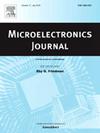Shrink eFPGA tile area by using custom cells and optimizing routing congestion
IF 1.9
3区 工程技术
Q3 ENGINEERING, ELECTRICAL & ELECTRONIC
引用次数: 0
Abstract
—Embedded FPGA (eFPGA) is widely used in SoC design because of its process portability and flexible programmability. However, the area of eFPGA always occupies a larger area ratio, and due to the limitation of the number of available metal layers, it is easy to cause routing congestion and lead to a larger area. FPGA-specific custom cells can significantly reduce the total cell area of eFPGAs. When designing these custom cells, it's crucial to consider not only their compact implementation but also their interconnections with other cells to minimize routing congestion. Beyond customizing cells, optimizing the connections of configuration memory cells can further optimize routing congestion. This paper is dedicated to optimizing the physical implementation of eFPGA tiles. An eFPGA-specific custom cell design method with compact circuit structure is proposed to reduce the cell area while considering the routing connections. A more complete routing optimization method is proposed to completely optimize the connections of configuration memory cells to reduce routing congestion. We validated our approach in a 28 nm technology and found that our optimization can save 22.63 % in area while improving 33.89 % of worst case path delay compared with the standard cell implementation.
求助全文
约1分钟内获得全文
求助全文
来源期刊

Microelectronics Journal
工程技术-工程:电子与电气
CiteScore
4.00
自引率
27.30%
发文量
222
审稿时长
43 days
期刊介绍:
Published since 1969, the Microelectronics Journal is an international forum for the dissemination of research and applications of microelectronic systems, circuits, and emerging technologies. Papers published in the Microelectronics Journal have undergone peer review to ensure originality, relevance, and timeliness. The journal thus provides a worldwide, regular, and comprehensive update on microelectronic circuits and systems.
The Microelectronics Journal invites papers describing significant research and applications in all of the areas listed below. Comprehensive review/survey papers covering recent developments will also be considered. The Microelectronics Journal covers circuits and systems. This topic includes but is not limited to: Analog, digital, mixed, and RF circuits and related design methodologies; Logic, architectural, and system level synthesis; Testing, design for testability, built-in self-test; Area, power, and thermal analysis and design; Mixed-domain simulation and design; Embedded systems; Non-von Neumann computing and related technologies and circuits; Design and test of high complexity systems integration; SoC, NoC, SIP, and NIP design and test; 3-D integration design and analysis; Emerging device technologies and circuits, such as FinFETs, SETs, spintronics, SFQ, MTJ, etc.
Application aspects such as signal and image processing including circuits for cryptography, sensors, and actuators including sensor networks, reliability and quality issues, and economic models are also welcome.
 求助内容:
求助内容: 应助结果提醒方式:
应助结果提醒方式:


